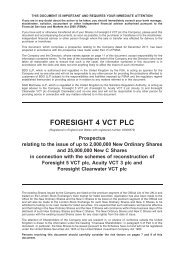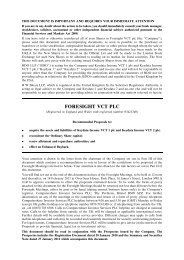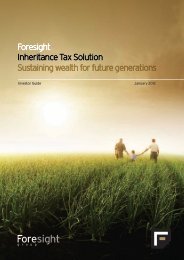Information Memorandum - Foresight Group
Information Memorandum - Foresight Group
Information Memorandum - Foresight Group
Create successful ePaper yourself
Turn your PDF publications into a flip-book with our unique Google optimized e-Paper software.
INTRODUCTION TO SOLAR POWER INVESTING<br />
Enough solar energy reaches the earth every hour to meet<br />
the world’s energy consumption for a whole year. The<br />
technology to harness some of this energy in the form of<br />
electricity is now tried and tested. Although it is generally a<br />
more expensive way to generate electricity than the burning<br />
of fossil fuels, solar power technology enjoys the support of<br />
government financial incentives as part of the UK Government’s<br />
drive to reduce greenhouse gas emissions by building<br />
renewable energy generating capacity.<br />
The European Union decided many years ago to promote<br />
renewable energy as part of the response to climate change.<br />
Over the last ten years, Germany, Spain and Italy among others<br />
have demonstrated how massive private sector investment in<br />
renewable energy can be unleashed by long term government<br />
support schemes. In the UK, the Renewable Obligation (as<br />
further detailed on page 13) has been adopted as the main<br />
mechanism for supporting the uptake of large-scale renewable<br />
electricity generation. It obliges electricity suppliers to source<br />
an increasing proportion of the electricity that they supply to<br />
customers from renewable sources and provides an additional<br />
income stream to renewable generators. The RO Scheme,<br />
thereby provides revenue support for electricity generated<br />
by qualifying Solar Power Plants.<br />
<strong>Foresight</strong> believes that solar power generation supported by<br />
the RO Scheme is attractive for investors in a time of economic<br />
uncertainty and austerity in government spending. While the<br />
level of government support has been reduced following the<br />
Renewable Obligation Banding Review (as further detailed on<br />
page 14), this follows years of substantial reductions in the<br />
cost of solar panels and, therefore, still allows for an attractive<br />
margin to be made by UK solar generators under the scheme.<br />
The UK Government has committed to ensure that 15% of all<br />
of the UK’s energy needs are met from renewable sources by<br />
2020 and this commitment implies a need for investment of an<br />
estimated £110 billion, part of which is expected to be directed<br />
to solar power.<br />
Having invested in solar power installations in Spain<br />
and Italy over the last five years, and with £50 million<br />
invested in UK Solar Power Plants, <strong>Foresight</strong> understands the<br />
exciting opportunities that government support can unlock<br />
for private investors. <strong>Foresight</strong> has strong relationships with<br />
developers, banks and other key counterparties and has a<br />
growing pipeline of investment opportunities. With a five year<br />
track record in solar power investing and an in-house team<br />
of experts in project finance, procurement and operations,<br />
<strong>Foresight</strong> intends to play a leading role in opening the solar<br />
power opportunity to private investors.<br />
Many people are aware of solar power, but have questions<br />
about how it works, whether it is efficient and how it can be<br />
used by investors to generate a profit. This introduction to<br />
solar power investing is intended to answer some of the<br />
more common questions.<br />
What is solar power?<br />
The building blocks of a solar power generator are<br />
photovoltaic cells, which convert light into electricity.<br />
They are typically made from layers of semiconducting<br />
material, usually silicon. Packaging a number of these<br />
photovoltaic cells into a frame, with a sheet of glass on the<br />
front to protect the layers of semiconducting material from<br />
weather and physical damage, creates a solar panel. A typical<br />
photovoltaic Solar Power Plant will comprise a number of<br />
solar panels connected together and linked to an inverter,<br />
an electrical device that converts the direct current (DC)<br />
generated by the panels into alternating current (AC), the<br />
form of electricity supplied through the mains electricity<br />
network. Panels may be mounted on rooftops or on the<br />
ground, and may be fixed or set to track the sun. Large<br />
numbers of photovoltaic systems have already been installed<br />
globally. Systems of this type are the main focus for the Fund<br />
and are referred to in this document as “Solar Power Plants”.<br />
Solar Panel Photovoltaic Cell<br />
anti-reflective coating<br />
silicon layers<br />
metal conductor strips<br />
metal backing<br />
What about watts?<br />
In order to calculate the potential revenue that a Solar Power<br />
Plant can generate, it is necessary to know both the value of<br />
each unit of electricity and the number of units that can be<br />
expected to be generated each year (known as the “annual<br />
output” which is measured in “kilowatt-hours (kWh)”). Annual<br />
output is a function of a Solar Power Plant’s peak capacity<br />
(measured in “kilowatts peak (kWp)”), the amount of solar<br />
energy reaching its panel(s), and a performance factor that<br />
allows for the alignment of the panels in relation to the sun,<br />
as well as the temperature and other factors.<br />
In the UK the average solar panel system generates an annual<br />
output of 850 kWh per 1kW rated system. For a typical 5MW<br />
installation this means around 4,250MW per year. Capacity is<br />
related to the physical size of the panels and the efficiency with<br />
which they convert solar energy into electricity. Efficiency is<br />
typically guaranteed by the panel manufacturer. Annual output<br />
is forecasted using meteorological data for average monthly<br />
sunlight levels for different geographical areas, allowing<br />
for weather and the number of daylight hours. <strong>Foresight</strong>’s<br />
experience suggests that estimates properly based on this<br />
data are reliable.<br />
(A megawatt (MW) = 1,000 kilowatts (kW); a gigawatt (GW) =<br />
1,000,000 kilowatts (kW) while 1MW is sufficient to power 1000<br />
homes in the UK.)<br />
FORESIGHT SOLAR EIS FUND 3<br />
11

















